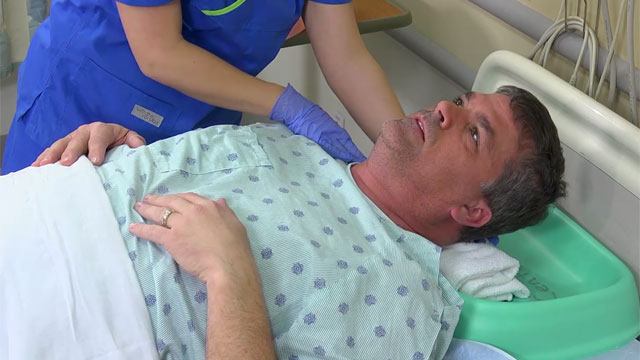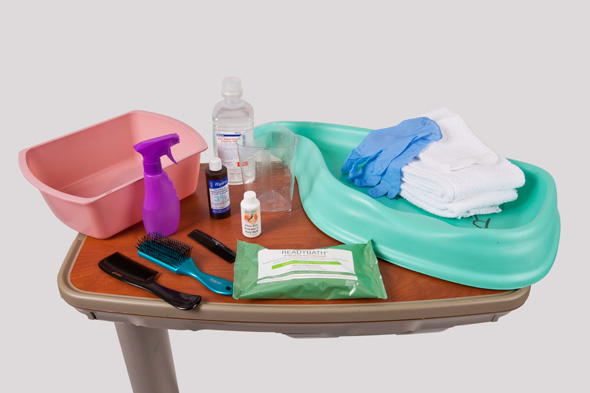Personal Hygiene and Grooming
Select a Skill:
- » Performing Oral Hygiene for an Unconscious Patient
- » Cleaning Dentures
- » Performing Hair Care and Shampooing in Bed
- » Shaving a Male Patient
- » Performing Nail and Foot Care
- » Assisting with a Gown Change
Take the Review Test:

Safety
- Obtain a physician’s order if it is required for washing hair.
- Before washing the patient’s hair, determine that there are no contraindications to the procedure.
- Make sure the patient’s condition does not contraindicate neck hyperextension. Use caution with patients who have suffered neck injuries, because flexion and hyperextension of the neck could cause further injury.
- Observe standard precautions when providing care, which includes wearing clean gloves. Additional precautions requiring other personal protective equipment (PPE) may be necessary, depending on the patient’s condition.
- Monitor patients who have a decrease in sensory perception, such as peripheral neuropathy.
- Patients with positional vertigo are not able to tolerate neck hyperextension if it increases their dizziness.
Equipment
(Roll cursor over items to see labels)

Comb and Hairbrush
Spray Bottle
Shampoo and Conditioner
Hydrogen peroxide (optional)
Saline solution (optional)
Water pitcher or Graduated measuring cylinder
Plastic shampoo board
Washbasin
Towels and washcloths
Waterproof pad
Clean Gloves
Disposable shampoo cap product (optional)
Delegation
The tasks of hair care, shampooing the hair of a bed-bound patient, and using a disposable shampoo product can be delegated to nursing assistive personnel (NAP). Be sure to inform NAP of the following:
- The proper ways in which to position the patient with head or neck mobility restrictions
- The proper ways in which to shampoo a patient’s hair when the patient has abrasions, scalp lacerations, or open wounds
- The proper procedure for using a medicated lice shampoo, stressing the steps to take in order to prevent transmission of the infestation to other patients
Preparation
- Before washing a patient’s hair, determine that there are no contraindications to the procedure. Certain medical conditions, such as head and neck injuries, spinal cord injuries, and arthritis, place the patient at risk for injury during shampooing because of positioning and manipulation of the head and neck. Ask the patient to indicate if he or she becomes uncomfortable.
- Inspect the condition of the hair and scalp. Assess for abrasions, lacerations, lesions, inflammation, and infestation (such as pediculosis).
- If infestation is present, wear a disposable gown in addition to clean gloves, and use a medicated shampoo.
- Explain the procedure, and assess the patient’s hair care product preferences, such as type of shampoo.
- Position the patient sitting in a chair or in the bed with the head of the bed elevated 45 to 90 degrees, as tolerated.
Follow-up
- Offer a mirror, and ask patient how the hair and scalp feel.
- Ask if the patient is satisfied with his or her degree of participation.
Documentation
Document hair care and shampooing if required by agency policy.
Review Questions
1. When preparing to assist a patient with hair care, why does the nurse first check the patient’s scalp for inflammation?
 To determine what type of shampoo to use
To determine what type of shampoo to use To plan enough time to perform hair care
To plan enough time to perform hair care  To determine if the patient can perform the care independently
To determine if the patient can perform the care independently  To ensure that the care can be performed without injuring the scalp
To ensure that the care can be performed without injuring the scalp
2. What is the primary reason the nurse encourages the patient to participate in hair care?
 To free up the staff’s time for patient care
To free up the staff’s time for patient care To make sure the care is performed according to the patient’s preferences
To make sure the care is performed according to the patient’s preferences  To encourage the patient’s sense of independence
To encourage the patient’s sense of independence  To allow the nurse to evaluate the patient’s ability to manipulate objects
To allow the nurse to evaluate the patient’s ability to manipulate objects
3. What is the purpose of parting the patient’s hair into sections?
 To identify the areas to be groomed
To identify the areas to be groomed To style the hair attractively
To style the hair attractively To check for pediculosis (head lice)
To check for pediculosis (head lice) To make brushing and combing more effective
To make brushing and combing more effective
4. For which of the following patients would it be necessary to use a disposable shampoo cap, rather than a shampoo board?
 An older adult woman with a drainage tube in place following a mastectomy
An older adult woman with a drainage tube in place following a mastectomy  An older adult man with a history of bleeding problems
An older adult man with a history of bleeding problems  A young woman whose arm and leg have been immobilized on the right side following a car accident
A young woman whose arm and leg have been immobilized on the right side following a car accident A young man who has sustained a fracture of the upper spine in a football game
A young man who has sustained a fracture of the upper spine in a football game
5. Which action should be avoided when providing hair care for a bed-bound patient with a history of dizziness?
 Raising the patient quickly into a sitting position after completing a bed shampoo
Raising the patient quickly into a sitting position after completing a bed shampoo Getting water into the patient’s ears during the rinsing phase of the shampoo
Getting water into the patient’s ears during the rinsing phase of the shampoo Placing the neck in a hyperextended position during the shampoo process
Placing the neck in a hyperextended position during the shampoo process Having the entire shampooing process last longer than 15 minutes
Having the entire shampooing process last longer than 15 minutes
You have completed the Review Questions for this skill. To take the Review again select the Start Over button. To proceed to another skill select from the dropdown menu. Select the Home or Back button to proceed to the next section.

